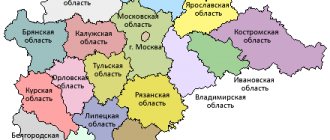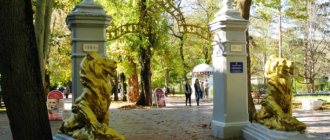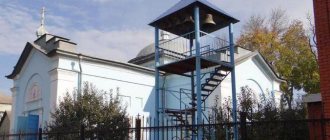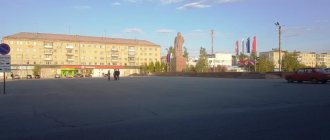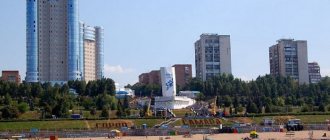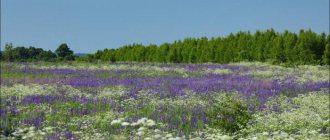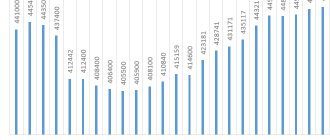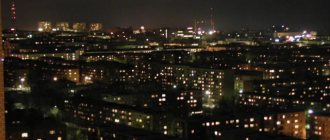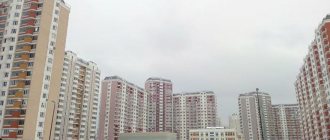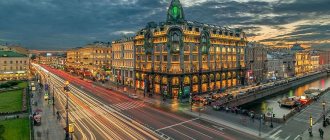This term has other meanings, see Hot Key (meanings).
| city[1] / urban district[2] | |
| Goryachy Klyuch city | |
| Flag | Coat of arms |
M4 near Goryachiy Klyuch
Municipal entity Goryachy Klyuch
- a municipal formation within the Krasnodar Territory of Russia, has the status of an urban district[4]. The administrative center is the city of Goryachiy Klyuch.
Formed on the territory of an administrative-territorial unit with a status corresponding to the category of the city of regional subordination of Goryachiy Klyuch
[5].
Population
| Population | ||||||
| 2002[6] | 2010[7] | 2011[8] | 2012[9] | 2013[10] | 2014[11] | 2015[12] |
| 51 640 | ↗57 289 | ↗57 381 | ↗58 333 | ↗59 300 | ↗60 444 | ↗61 904 |
| 2016[13] | 2017[14] | 2018[15] | 2019[16] | 2020[17] | 2021[3] | |
| ↗63 615 | ↗65 045 | ↗66 008 | ↗67 981 | ↗69 702 | ↗71 609 | |
Psekups River in the vicinity of Goryachiy Klyuch
Bald Mountain
One of the most noticeable mountains in the vicinity of the resort is Bald Mountain. This peak is located near Anapa and the village of Varvarovka. The total height is 423 meters above sea level. The surface of the mountain is very densely overgrown with vegetation, which gives a special flavor to the resort town.
At the top of the mountain you can find a monument to the warrior-defenders who defended these places during the Great Patriotic War. Very fierce battles were fought here for Bald Mountain and the Wolf Gate, as a result of which Soviet soldiers demonstrated all the fortitude and colossal will to win against outnumbered opponents. The defense of the 423-meter height was held by the 30th Irkutsk Division, in whose honor this monument was erected.
Settlements
The city of Goryachy Klyuch and 7 rural districts subordinate to it.
The urban district and the city of regional subordination of Goryachiy Klyuch includes 31 settlements[4][18][5]
| List of settlements | |||
| № | Locality | Type of settlement | Population |
| 1 | Baku | village | ↗2519[7] |
| 2 | Unnamed | village | ↗883[7] |
| 3 | Funny | farm | ↗76[7] |
| 4 | Hot key | city, administrative center | ↗41 604[3] |
| 5 | Houses | farm | ↗23[7] |
| 6 | Imeretinskaya | village | ↗1609[7] |
| 7 | Red East | farm | ↗78[7] |
| 8 | Kura-Promysel | village | ↘0[7] |
| 9 | Kura-Transport | village | ↗42[7] |
| 10 | Kura-Tsetse | farm | ↘164[7] |
| 11 | Kutais | village | ↗1081[7] |
| 12 | Kutaisi | village | ↗324[7] |
| 13 | Martanskaya | village | ↗1245[7] |
| 14 | Peaceful | village | ↘735[7] |
| 15 | Molkin | farm | ↗3303[7] |
| 16 | October | village | ↗237[7] |
| 17 | Fern | farm | ↗84[7] |
| 18 | Pervomaisky | village | ↗2635[7] |
| 19 | Prirechensky | village | ↗1162[7] |
| 20 | Commercial | village | ↗25[7] |
| 21 | Pyatigorskaya | village | ↗1040[7] |
| 22 | Saratovskaya | village | ↗6567[7] |
| 23 | Northern | farm | ↗49[7] |
| 24 | Salty | farm | ↗24[7] |
| 25 | Sorokin | farm | ↘22[7] |
| 26 | Suzdal | village | ↗1374[7] |
| 27 | Transport | village | ↘103[7] |
| 28 | Phanagorian | village | ↗515[7] |
| 29 | Khrebtovoye | village | ↘11[7] |
| 30 | Black Sea | village | ↗868[7] |
| 31 | Wide Beam | village | ↘365[7] |
The city of Goryachy Klyuch as an object of the administrative-territorial structure of the Krasnodar Territory consists of the city of regional subordination of Goryachy Klyuch and 7 rural districts subordinate to it, which in turn include 30 rural settlements.[4][18][5]
See also: Rural districts subordinate to Goryachiy Klyuch
Abolished settlements
The following settlements were previously located on the territory of the municipality:
- Abkhazskaya (stanitsa)
- Penza (stanitsa)
- Khatyps (settled in 1957 in the villages of Fanagoriyskoye and Bezymyanoye)
Archeology
The Paleolithic sites of Ignatenkov Kutok and Sorokin are located between the village of Saratovskaya and the Sorokin farm. The culture-containing layer of the Ignatenki Kutok locality belongs to the marine isotopic stage [en] MIS 9 (~330-290 thousand years ago), which corresponds to the intra-Ris interglacial of the Middle Pleistocene. The stone industry of the Ignatenki Kutok locality is defined as Acheulian, containing handaxes, pikes and other large cutting tools. The culture-containing layer of the Sorokin locality belongs to the marine isotopic stage MIS 7 (~250–200 thousand years ago) and is synchronous with the Middle Pleistocene Uzunlar terrace/transgression of the Black Sea. The stone industry of the Sorokin locality dates back to the end of the Early Paleolithic and is distinguished by the presence of Levallois technology of primary splitting and the production of double-sided butt knives (keilmessers). A similar stone industry was identified at the Tenginsky location on the left bank of the Shapsukho River on the southeastern outskirts of the village of Tenginka[20].
Dante's Gorge
Dantovo&&
Then the so-called “path of health” begins, opening with a passage in the rock, which received a beautiful name - “Dante’s Gorge” - a fracture in the rock. But before entering Dante’s Gorge, located between boulders, hardly anyone can resist trying to climb the mountain along specially hollowed-out recesses for hands and feet. This unique “attraction” is called the Rock of Temptation, since few people will pass by and not be tempted to climb up. Of course, children especially like this - there are always a lot of school excursion groups here from early spring until late autumn.
Dantovo&&
The Dante Gorge itself is not very long, but very picturesque, the maximum depth of the fault is 15 meters, stone steps lead up between the stone blocks, a stream babbles nearby, the water in which is clean and drinkable. True, again the impression is spoiled by the “rock paintings” of modern “cave people”. The fact is that the rock here is very soft, easily amenable to a knife, which is why everyone strives to leave a “good” memory of themselves here.
Dantovo&&
Dantovo&&
Having climbed up Dante's Gorge, you need to follow a path that turns in the opposite direction and runs parallel to the gorge almost directly above it. From the path you can look down and see a gorge and a stream. Moving further, you can look at the Mineral Glade from above.
Dantovo&&
Dantovo&&
Notes
- from the point of view of the administrative-territorial structure
- from the point of view of the municipal structure
- ↑ 123
The permanent population of the Russian Federation by municipalities as of January 1, 2022 (Russian). Retrieved April 27, 2022. Archived May 2, 2022. - ↑ 123
Charter of the municipal formation of the city of Goryachy Klyuch, Krasnodar Territory - ↑ 123
Register of names of geographical objects on the territory of the Krasnodar Territory as of January 26, 2017 // State catalog of geographical names (Rosreestr) - All-Russian population census 2002. Volume. 1, table 4. Population of Russia, federal districts, constituent entities of the Russian Federation, districts, urban settlements, rural settlements - regional centers and rural settlements with a population of 3 thousand or more (unspecified)
. Archived from the original on February 3, 2012. - ↑ 1 2 3 4 5 6 7 8 9 10 11 12 13 14 15 16 17 18 19 20 21 22 23 24 25 26 27 28 29 30 31 All - Russian
population census 2010.
Volume 1, table 4. Urban and rural population by gender in the Krasnodar Territory (unspecified)
. Retrieved January 2, 2015. Archived January 2, 2015. - Krasnodar region. Estimated resident population as of January 1, 2009-2014
- Population of the Russian Federation by municipalities. Table 35. Estimated resident population as of January 1, 2012 (unspecified)
. Retrieved May 31, 2014. Archived May 31, 2014. - Population of the Russian Federation by municipalities as of January 1, 2013. - M.: Federal State Statistics Service Rosstat, 2013. - 528 p. (Table 33. Population of urban districts, municipal districts, urban and rural settlements, urban settlements, rural settlements) (undefined)
. Retrieved November 16, 2013. Archived November 16, 2013. - Population estimate as of January 1, 2014 for municipalities of the Krasnodar Territory (unspecified)
. Retrieved April 27, 2014. Archived April 27, 2014. - Population of the Russian Federation by municipalities as of January 1, 2015 (unspecified)
. Access date: August 6, 2015. Archived August 6, 2015. - Population of the Russian Federation by municipalities as of January 1, 2016 (Russian) (October 5, 2018). Retrieved May 15, 2022. Archived May 8, 2022.
- Population of the Russian Federation by municipalities as of January 1, 2022 (Russian) (July 31, 2017). Retrieved July 31, 2022. Archived July 31, 2022.
- Estimated population as of January 1, 2022 for municipalities of the Krasnodar Territory (unspecified)
. Date accessed: March 23, 2022. - Population estimate as of January 1, 2022 for municipalities of the Krasnodar Territory (unspecified)
. Access date: April 10, 2022. - Estimated population as of January 1, 2022 for municipalities of the Krasnodar Territory (unspecified)
. Access date: April 16, 2022. - ↑ 12
03 409 - Information from the register of registered mass media
- Shchelinsky V. E., Kuznetsov E. V.
et al. Locations of Sorokin and Ignatenkov Kutok on the terraces of the river. Psekups (Transkuban) in the context of the Early and Middle Paleolithic of the North-West Caucasus // Early Paleolithic monuments and the natural environment of the Caucasus and adjacent territories in the Early-Middle Pleistocene. St. Petersburg: Petersburg Oriental Studies, 2022. - 144 p. (Archaeologica Petropolitana)
Mineral glade
If you turn right from the pillar (from the side where the inscription is), you will follow the path towards Mineral Glade. This is a kind of “heart” of the park. Abadzekhskaya Mountain rises above the clearing. Here and there on the hills you can see images of white birds - or swans, or cranes. Perhaps this is connected with some ancient legend, but, unfortunately, I don’t know which one. The places are very beautiful, however, the overall impression is spoiled by the numerous “autographs” left by modern savages.
Hot&&
The mineral clearing is a large rectangular area artificially excavated from the rock. It is not by chance that the glade is called this way, since it was here that the Psekup mineral waters came to the surface - the main treasure of these places.
Hot&&
For a long time, this place was not well-maintained, but the local tribes who lived here (the ancestors of the Circassians), and then pilgrims, still made their way to the springs for healing water. Today everything here is equipped and improved, but water from the sources no longer reaches the surface - it is diverted through special pipes to the drinking gallery.
Hot&&
The glade is located among the hills, so it is very quiet and peaceful here, in addition, there are several interesting objects located on it. The first is an obelisk standing in the very center of the site, dedicated to... mineral water of the resort. Yes, yes, it is considered the only monument in the world in honor of the mineral waters that healed many people, giving them strength, health and longevity, as well as in honor of “all those who worked to create the resort” (as it is written on the monument itself). The monument was erected in this place in honor of the 50th anniversary of the founding of the resort, in 1914.
Hot&&
The healing spring of St. Panteleimon is also located here. The water in the source is saturated with iron, so it has a specific taste - as if you are drinking from rusty dishes, a very unpleasant taste of rust remains in your mouth. The water flows very slowly, so it takes a lot of time to fill the bottle, and you risk having a long line behind you. But there is no point in putting this water into a bottle, since it very quickly loses its properties - the iron precipitates after just a few minutes. Therefore, it is better to come up with a glass and take a few sips, and also wash your face. This water is believed to have a rejuvenating effect. You can place a candle nearby.
Hot&&
Hot&&
Hot&&
In the mineral clearing there is an interesting chapel, very small, and as if it had grown out of a rock. This is the chapel of the Iveron Mother of God; it was erected here in the 19th century. Its internal part is a small grotto or cave carved into the Abdzekh rock, to which is adjacent a blue extension with a turret. Nearby there is a small recess in the form of a stone arch, reminiscent of the fact that there used to be another spring here - the Iversky Spring. the source was here back in the 20s of the last century, but after the shifts of mountain layers that occurred here, the source disappeared.
Hot&&
